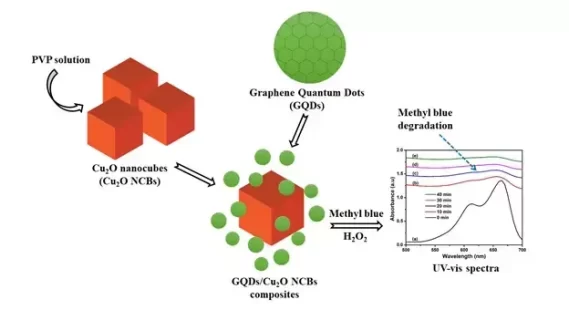Cuprous oxide nanocubes functionalized with graphene quantum dots and its application for methylene blue degradation
Authors
- Quyen Thi Bich Tran * 1
- Dang Hai Pham 1
- My Nguyen Tra Ngo 1
- Toan Duy Pham 2
- Thien Van Hong Doan 1
- Thanh Huynh Vu Luong 1
Abstract
Cuprous oxide nanocubes (Cu2O NCBs) were successfully functionalized with graphene quantum dots (GQDs) to form GQDs/Cu2O NCBs composites material with highly plasmonic property and photocatalytic activity. Herein, GQDs were synthesized by a hydrothermal method at 190°C for 8 h using natural sources of wheat flour and ascorbic acid as precursors and reducing agents, respectively. Cu2O NCBs were prepared via a simple chemical reduction method at room temperature. GQDs/Cu2O NCBs composites were fabricated by the simple mixing of the two corresponding component dispersions. Characterized by ultraviolet-visible spectroscopy (UV-Vis), Fourier transform infrared spectroscopy (FTIR), X-ray diffractometry (XRD), transmission electron microscopy (TEM), and energy-dispersive X-ray spectroscopy (EDX), the GQDs/Cu2O NCBs structures were confirmed. The composites possessed cubic shape of Cu2O and spherical shape of GQDs with average particle sizes respectively being ~70-80 nm, and ~3-8 nm; and an elemental composition of C (41.53%), O (47.03%), N (0.24%), and Cu (11.20%). Moreover, experiments on the methylene blue (MB) degradation demonstrated that the GQDs/Cu2O NCBs composites significantly degraded >98% of the total dye amount within 30 min. In summary, the novel composites possessed potential high catalytic activity and could be utilized as photocatalysts in the treatment of organic pollutants and biological waste such as dyes, antibiotics, and pesticides.




